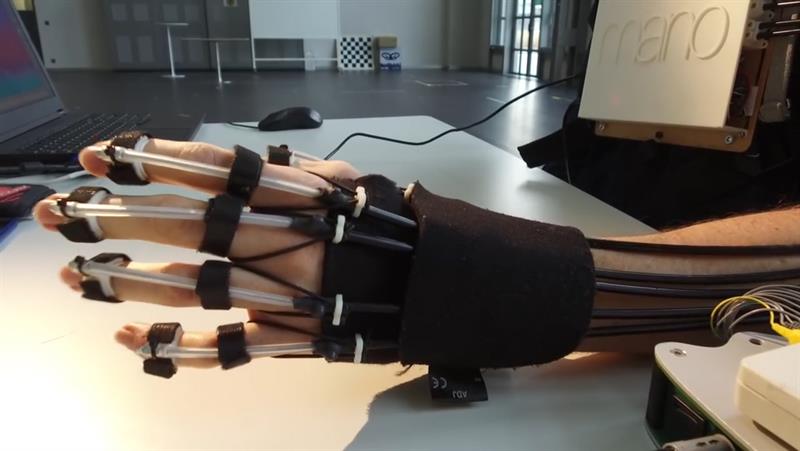Easily and quickly strapped to the joints with Velcro, patients can be equipped with the hand-exoskeleton in just a few minutes. Metal cables act as soft tendons along the back-side of each finger, leaving the palm free in order to maximise sensations felt by the hand. A chest-pack contains motors that can push and pull on the different cables, flexing the fingers when the cables are pushed and extending them when pulled.
The exoskeleton is adaptable by design, so that the control interface can be chosen according to the residual physical ability of the patient. The control interface can then be chosen from a variety of systems, from eye-movement monitoring for the severely paralysed, to smartphone-based voice interfaces, residual muscular activity of the damaged limb, all the way to reading brainwave activity with a headset.
The scientists decided to pursue brainwave-control of the exoskeleton via an EEG headset that measures the users’ brainwaves as they used the exoskeleton. They found that the hand motions induced by the device elicit brain patterns typical of healthy hand motions. But they also discovered that exoskeleton-induced hand motions combined with a user-driven brain-machine interface lead to peculiar brain patterns that could facilitate control of the device.
 The motor cortex is the part of the brain that controls body movement, and is divided into a left- and a right-hand side. The right motor cortex is mostly active during control of the left hand, and vice versa, a property of the nervous system called contralateral control.
The motor cortex is the part of the brain that controls body movement, and is divided into a left- and a right-hand side. The right motor cortex is mostly active during control of the left hand, and vice versa, a property of the nervous system called contralateral control.
Contralateral brainwave activity was observed in people who passively received hand motion by the exoskeleton. But they also noticed that, when the subjects were asked to control the hand-exoskeleton with their brainwaves, consistent same-side patterns also emerged in the brainwave data.
The scientists believe that this brain activity emerging from the combination of voluntary control and coherent feedback provided by the device could be exploited for improving brain control of these devices.
“This enhanced control of the hand-exoskeleton with brainwave activity is most likely due to higher engagement of subjects facilitated by rich sensory feedback provided by the nature of our exoskeleton,” explained lead scientist, José Millán. “Feedback is provided by the user’s perception of position and movement of the hand, and this proprioception is essential.”
So far, the hand-exoskeleton has been tested with patients with disabilities due to strokes and spinal cord injuries. The next steps involve improving the system both for assistive purposes, for performing tasks at home, or even as a tool for rehabilitation.





